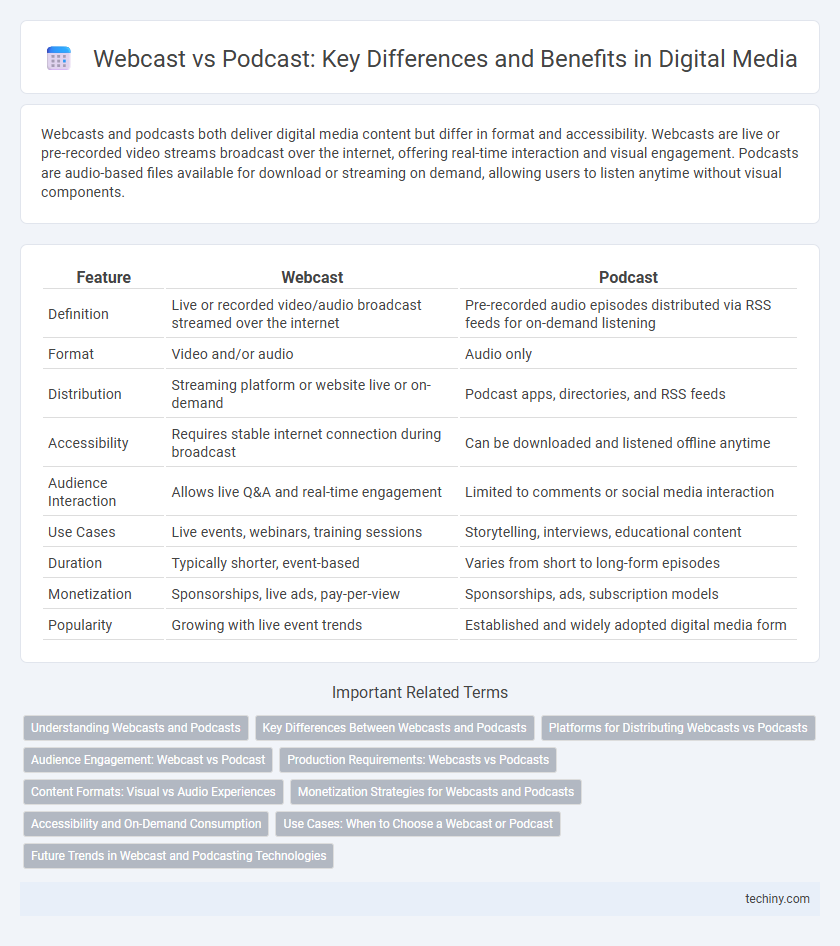Webcasts and podcasts both deliver digital media content but differ in format and accessibility. Webcasts are live or pre-recorded video streams broadcast over the internet, offering real-time interaction and visual engagement. Podcasts are audio-based files available for download or streaming on demand, allowing users to listen anytime without visual components.
Table of Comparison
| Feature | Webcast | Podcast |
|---|---|---|
| Definition | Live or recorded video/audio broadcast streamed over the internet | Pre-recorded audio episodes distributed via RSS feeds for on-demand listening |
| Format | Video and/or audio | Audio only |
| Distribution | Streaming platform or website live or on-demand | Podcast apps, directories, and RSS feeds |
| Accessibility | Requires stable internet connection during broadcast | Can be downloaded and listened offline anytime |
| Audience Interaction | Allows live Q&A and real-time engagement | Limited to comments or social media interaction |
| Use Cases | Live events, webinars, training sessions | Storytelling, interviews, educational content |
| Duration | Typically shorter, event-based | Varies from short to long-form episodes |
| Monetization | Sponsorships, live ads, pay-per-view | Sponsorships, ads, subscription models |
| Popularity | Growing with live event trends | Established and widely adopted digital media form |
Understanding Webcasts and Podcasts
Webcasts deliver live or on-demand video content over the internet, enabling real-time interaction and visual engagement with audiences during events or presentations. Podcasts provide pre-recorded audio episodes that listeners can subscribe to and consume asynchronously, making them ideal for storytelling, interviews, and educational content. Both formats serve different user preferences and content strategies, with webcasts emphasizing immediacy and visual elements, while podcasts prioritize convenience and auditory learning.
Key Differences Between Webcasts and Podcasts
Webcasts deliver live or on-demand video content streamed over the internet, offering interactive features such as real-time chat and Q&A sessions, while podcasts provide downloadable audio episodes intended for passive consumption on various devices. Webcasts often require higher bandwidth and support visual engagement, making them ideal for webinars and live events, whereas podcasts emphasize portability and convenience, catering to listeners on the go. Key differences include format (video vs. audio), interactivity level, and typical usage scenarios, influencing audience engagement and content delivery strategies in digital media.
Platforms for Distributing Webcasts vs Podcasts
Webcasts primarily utilize streaming platforms such as YouTube Live, Vimeo, and Facebook Live, enabling real-time interaction with viewers. Podcasts are distributed through audio-centric platforms like Apple Podcasts, Spotify, and Google Podcasts, focusing on on-demand listening experiences. Both formats leverage platform-specific features to optimize content reach and audience engagement.
Audience Engagement: Webcast vs Podcast
Webcasts foster real-time audience engagement through live chats, Q&A sessions, and interactive polls, creating a dynamic and immediate connection between hosts and viewers. Podcasts provide asynchronous consumption, allowing listeners to engage at their convenience, often leading to deeper, more personal connection via storytelling and episodic content. Both formats leverage unique engagement strategies, with webcasts excelling in immediacy and podcasts in long-term loyalty and community building.
Production Requirements: Webcasts vs Podcasts
Webcast production demands robust video recording equipment, reliable streaming platforms, and high-bandwidth internet to support live broadcasting with real-time interaction, while podcast creation typically requires high-quality audio recording devices, editing software, and hosting services optimized for on-demand audio content distribution. Webcasts often involve a larger production team to manage live video feeds, graphics, and audience engagement tools, contrasting with the more streamlined podcast production process that emphasizes clear audio and content scripting. Effective webcast production prioritizes seamless live delivery and viewer experience, whereas podcast production focuses on polished post-production audio quality and episodic content consistency.
Content Formats: Visual vs Audio Experiences
Webcasts provide a visual content format combining live video streaming with real-time interaction, enhancing viewer engagement through dynamic presentations and screen sharing. Podcasts focus exclusively on audio experiences, allowing for deeper storytelling and on-the-go consumption without the need for visual attention. Choosing between webcasts and podcasts depends on whether the audience prioritizes immersive visual content or flexible, audio-only accessibility.
Monetization Strategies for Webcasts and Podcasts
Webcasts generate revenue primarily through live event sponsorships, pay-per-view access, and interactive advertisements that capitalize on real-time audience engagement. Podcasts often monetize via dynamic ad insertion, listener subscriptions, and affiliate marketing, leveraging on-demand consumption and niche audience targeting. Both formats benefit from data analytics to optimize monetization by understanding listener behavior and refining content delivery.
Accessibility and On-Demand Consumption
Webcasts offer live streaming capabilities that enhance real-time accessibility for audiences, enabling interactive participation during events, while podcasts provide easily downloadable episodes for flexible, on-demand consumption across various devices. Podcasts cater to listeners seeking convenience and repeated access to content without time constraints, whereas webcasts prioritize immediacy and engagement through scheduled broadcasts. Both formats utilize digital platforms to maximize reach, but podcasts dominate in terms of user control and content longevity.
Use Cases: When to Choose a Webcast or Podcast
Webcasts excel in live event broadcasting, product launches, and interactive webinars where real-time audience engagement is essential. Podcasts are ideal for on-demand content consumption, storytelling, interviews, and educational series that listeners can access anytime, anywhere. Choosing between a webcast and podcast depends on the need for immediacy and interaction versus convenience and episodic content delivery.
Future Trends in Webcast and Podcasting Technologies
Webcast and podcast technologies are evolving rapidly with advancements in AI-driven content personalization and interactive features enhancing user engagement. Streaming quality improvements and real-time analytics integration are set to revolutionize how audiences consume digital media, enabling creators to optimize content delivery dynamically. Emerging trends also include augmented reality (AR) and virtual reality (VR) experiences within webcasts, alongside increased use of automated transcription and multilingual support for podcasts, expanding accessibility and global reach.
Webcast vs Podcast Infographic

 techiny.com
techiny.com